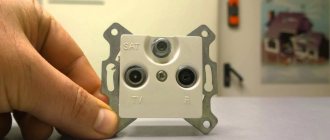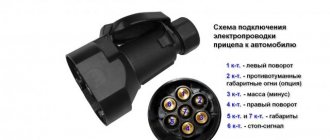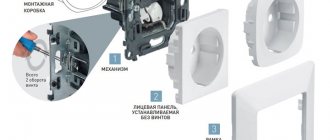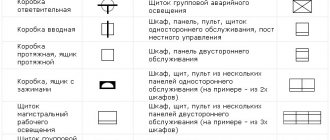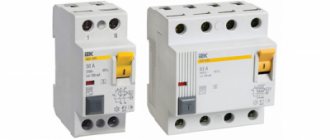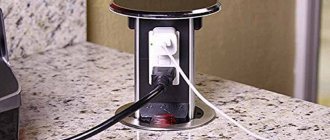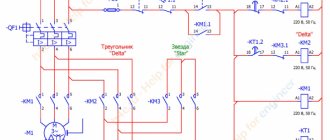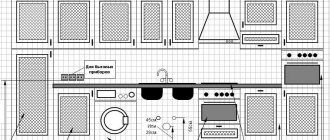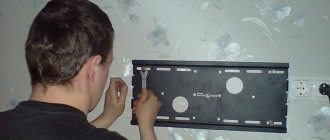Electrician in the house
Encyclopedia about electricity from A to Z
Masters catalog
Find the best master or company in your city
Termination TV socket
At the moment, television sockets are quite widely represented on the market and are increasingly used. At the same time, quite often one can encounter complaints about their operation and the quality of the television signal transmitted by such sockets.
But in most cases, these complaints are unfounded, and the low signal quality is associated with the wrong choice of sockets themselves. Therefore, in order not to be disappointed in this electrical installation equipment and not throw money away, let’s look into this issue.
- Connection diagrams for TV sockets Feed-through diagram
- Star scheme
- Selecting TV outlets
Connection diagrams for TV sockets
First of all, let's look at the possible options for connecting television outlets. After all, the subsequent choice of the type of TV sockets for installation directly depends on this. At the moment, connection schemes are actively used - through-type and star-type.
Passage scheme
Let's start with the less commonly used, but cheaper and easier to install, pass-through circuit. The essence of this scheme is to connect all TV sockets in series and then connect an antenna to the first one.
Pass-through diagram for connecting TV sockets
So:
- The main feature of this circuit is that for each subsequent socket, the previous one is the source of the signal. In this regard, certain problems arise related to both the level of signal drop and the need to reduce the level of the reflected signal.
- In order to fulfill these requirements, a television terminal and pass-through socket is used. The terminal socket is installed at the end of this loop, and all other TV sockets in the loop must be pass-through.
- The main disadvantage of this type of connection is the reduction in signal level at each subsequent outlet. So usually the drop in signal level at each subsequent outlet is at least 13 - 15 dB.
Note! According to GOST 28324-89, the signal level should be 57 - 83 dB. That is, even at the maximum level of the received signal, installing more than two pass-through sockets will reduce its level below the maximum permissible values. In this regard, it is likely that the image quality will decrease.
- The TV terminal socket is no exception and the drop in signal level on it is no less. The fact is that to reduce the level of the reflected signal, a special circuit is used, which suppresses this signal. A side effect of this suppression is a decrease in signal level. If you “bite” it, as some craftsmen suggest, then the effect of overlapping images of different TVs in the cable is quite likely.
- Not a disadvantage, but a significant limitation, is the impossibility of using a pass-through circuit to create a digital television network. In this regard, a terminal and feed-through TV socket with a SAT output intended for satellite digital television will not be effective. At the same time, terminal sockets are actively used in digital television, if this is the only socket connected to the receiver.
Star scheme
To implement the so-called “star” circuit, in addition to the sockets itself, you will need a splitter or, as it is also called, a signal multiplier. The price of this device is not that high, but the signal level in all outlets will be the same.
In addition, in most cases it comes with a built-in amplifier, which allows you to achieve the ideal signal level.
Connection diagram for TV sockets "star"
So:
- For the star circuit, our instructions recommend using only single sockets. Moreover, their cost is slightly lower than other types of TV sockets. This is due to the fact that they do not have any additional circuits. After all, interference suppression occurs in the splitter and is not needed directly in the outlet.
- The signal drop level in such sockets usually does not exceed 1 - 3 dB. And by and large, this drop is associated only with switching processes. Therefore, if the connection is made in a high-quality manner, then such losses can be completely neglected.
- The main disadvantage of the star circuit is its higher cost and complexity of installation. It is associated with the installation of additional equipment and the need to lay more television cable. But as they say, quality requires sacrifice.
Note! When installing a television network according to a “star” scheme, it is not recommended to lay television cables in one groove. In addition, it is advisable to separate television cables from power equipment. After all, power wires can not only cause interference, but if they are damaged, they can ruin the entire television network, and in the worst case, all connected televisions.
How to distinguish a star, end, terminal and through socket?
We replace electrical wiring, switches and sockets around the house. Can you tell me how to distinguish between a star, terminal, terminal and through socket? What to look for?
We replace electrical wiring, switches and sockets around the house. Can you tell me how to distinguish between a star, terminal, terminal and through socket? What to look for?
Someone decided to install sockets, but cannot distinguish them visually, there is a mountain of everything, and it is not clear where which one is. It is difficult for a non-electrician to distinguish sockets from each other, since an inexperienced user does not know the basics of their differences. First, let's understand the terms terminal and end - they are the same thing.
Selecting and connecting terminal sockets
As you can see, simply by understanding the connection diagrams for TV sockets, we have determined where and when the terminal television socket is used and how it differs from other types of TV sockets. Now it remains to decide what to pay attention to when choosing and how to connect such electrical installation devices.
Selecting TV outlets
First of all, let's decide on the parameters that you should pay attention to when choosing a terminal TV outlet. We have already talked about some of them above, but now we will dwell on them in more detail.
How to choose a TV outlet
So:
- Each outlet has a certain level of signal drop at the input. This is due to both switching processes and the way the wire is attached to the socket. At the moment, the screw and clamping methods are used, and it is impossible to say which one is better. But you can pay attention to the level of losses: usually the drop in signal level is about 1 - 3 dB.
- But as we already mentioned, the terminal socket contains a so-called filter. On it, the signal level drop is much higher and usually ranges from 10 to 15 dB. If this value is lower, then the quality of this filter should raise questions in your mind.
- As you know, video and audio signals can be transmitted over a wide range of frequencies, which is limited by standards. So the most common is EN500837. It adjusts parameters in the frequency range 30 – 2150 MHz. Our GOST R 52023 defines parameters ranging from 40 to 1000 MHz. But the DOCSIS v.2.0 standard applies to frequencies from 47 to 862 MHz. Typically, the frequency range of TV outlets meets one of these standards.
- Well, the last parameter that is worth paying attention to is the reliability of the fastenings and the appearance of the outlet. Little-known manufacturers often sin by using low-quality plastic. In addition, pay attention to the clarity of the method of attaching the cable. After all, many well-known manufacturers produce sockets with lightweight, but “complicated” installation methods.
Connecting the terminal socket
And finally, we’ll come to the issue of connecting terminal TV sockets. It is quite possible to perform this action with your own hands and you do not need any special knowledge for this. Yes, and a special tool too.
Connecting a TV outlet
So:
- To connect, first of all we strip the cable . You can see how to do this correctly in the photo.
- Now unscrew the clamping screws directly on the socket. We insert the cable and check that the braid does not come into contact with the central core. After this we clamp the cable. This completes the connection.
- Some manufacturers have tried to make the installation of the socket as easy as possible. There are a variety of clamping mounts available for this purpose. Thus, the manufacturer Legrand offers TV sockets with a clamp based on a hinged lock, some offer spring clamps, and so on. It is almost impossible to describe each of them. But they are all based on reliable fastening of the cable braid separately and the central core separately.
Types of TV sockets
TV sockets are classified according to their functional characteristics and the way the cable is secured inside. You should pay attention to the functionality first of all after choosing the scheme according to which installation will take place. There are three types of TV sockets:
The devices of the first two types are almost identical. They have a place for cable entry and a socket for connecting a TV. The only difference is that in the terminal socket there is an additionally installed 75 Ohm resistor, while in a single socket the role of resistance is played by the TV connected to it.
If you install a single TV socket at the end of the connection according to the “Loop” diagram, but for some reason do not connect a TV receiver to it, interference will be observed on the remaining TVs in the chain. The same will happen when using single-type devices in a “Star” circuit. Therefore, when connecting several TV receivers, only terminal sockets are chosen.
Tip: even if you are going to install only one TV in your apartment, install an end socket instead of a single one. If you ever decide to expand your home TV network, you won't have to worry about connectivity.
The pass-through TV socket is designed to connect several TVs using the “Loop” scheme. It has two clamps - for the incoming cable and for the output of the wire going to the next device. Some manufacturers combine these clamps into one connector; pay attention to this when purchasing so that the installation itself does not cause you any difficulties.
Tip: before purchasing, study the model you have chosen to understand how it implements the mechanism for connecting the cable to the outlet. Some manufacturers have a convenient locking cover that presses the wire into place. For others, the cable is secured with bolts, just like a regular electrical outlet. Choose a model that will be convenient for you to work with.
How to choose a TV socket by installation type
In a good way, it is advisable to hide all cables in the walls, like ordinary power cables. Then there will be no tails anywhere and no damage to them. Hidden cabling is the best option and with the right cable, you will completely forget about its existence. If you have such wiring done or are just in the process of renovation, then take hidden TV sockets.
But if no repairs are planned, and there are suddenly more TVs, the installation will be external. It can be done using baseboards with channels and cable ducts. In this case, overhead television sockets are needed.
TV socket wall mounting Legrand Quteo, but if you want to get a better signal, choose cables from the first list. An RG-6 cable can be used to connect the TVs themselves to sockets. How to connect a TV cable to an outletThe power antenna cable is connected to the socket in a special socket using a screw. The central core is carefully removed from the insulation and secured in the hole. For better fixation, a part of the braided cable is secured with a second screw through a special plate. This ensures that there is no movement and protects the central core from fracture.
|
